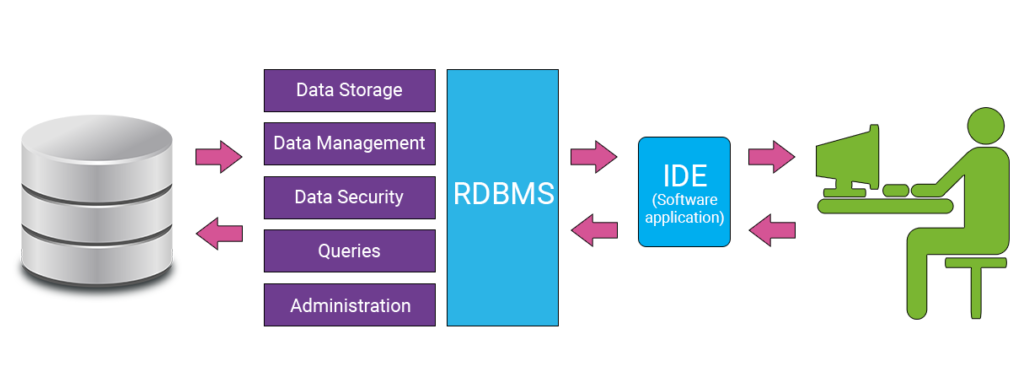
An outline for a Database Management System (DBMS) and Relational Database Management System (RDBMS) syllabus, designed to take students from basic to intermediate levels. This structured syllabus will cover essential concepts, hands-on skills, and SQL knowledge required to understand, design, and manage databases effectively.
DBMS & RDBMS Syllabus Overview (Basic to Intermediate Level)
Module 1: Introduction to Databases and DBMS
- Understanding Databases: Definition, purpose, and types of databases.
- Introduction to DBMS: Overview of DBMS, its functions, and how it manages data.
- DBMS Architecture: Components of DBMS – data, software, users, and process.
- Types of DBMS: Hierarchical, network, relational, and object-oriented databases.
- Advantages and Disadvantages of DBMS: Data integrity, redundancy, security, and limitations.
Module 2: Data Models
- Data Modeling Concepts: Understanding what a data model is and why it’s essential.
- Entity-Relationship (ER) Model: Components of ER models – entities, attributes, and relationships.
- ER Diagrams: How to draw ER diagrams and interpret relationships (one-to-one, one-to-many, many-to-many).
- Relational Model: Basics of relational models, tables, and relationships.
Module 3: Introduction to RDBMS
- Definition of RDBMS: Difference between DBMS and RDBMS, and RDBMS characteristics.
- RDBMS Structure: Tables, rows, columns, and schema.
- Keys in RDBMS: Primary key, foreign key, candidate key, and composite key.
- Normalization: Understanding normalization and its types (1NF, 2NF, 3NF, BCNF).
- Advantages of RDBMS: Data integrity, security, scalability, and relational structure.
Module 4: SQL Basics
- Introduction to SQL: Definition and purpose of SQL, types of SQL statements.
- SQL Data Types: Understanding data types (INT, VARCHAR, DATE, etc.).
- Creating and Managing Databases: Basic SQL commands to create, delete, and use databases.
- Creating Tables: Using
CREATE TABLEand defining columns with constraints.
Module 5: SQL Queries and Data Manipulation
- Basic SQL Queries:
SELECT,FROM,WHEREclauses for data retrieval. - Filtering Data: Using
WHERE, logical operators, and conditions to filter data. - Sorting Data: Using
ORDER BYfor sorting results in ascending/descending order. - Data Manipulation Commands:
INSERT,UPDATE, andDELETEfor managing data in tables.
Module 6: Advanced SQL Functions
- Aggregate Functions: Using
COUNT,SUM,AVG,MIN,MAXfor data analysis. - Grouping Data:
GROUP BYandHAVINGclauses for grouping and filtering groups. - String Functions:
CONCAT,SUBSTRING,LENGTH, etc., for text manipulation. - Date and Time Functions: Working with dates using
NOW(),CURDATE(),DATEDIFF(), etc. - Math Functions: Basic math functions like
ROUND,CEIL,FLOOR, etc.
Module 7: Joins and Subqueries
- Introduction to Joins: Understanding joins and their purpose in combining tables.
- Types of Joins:
INNER JOIN,LEFT JOIN,RIGHT JOIN,FULL OUTER JOIN. - Using Joins in Queries: Writing queries using joins to retrieve related data from multiple tables.
- Subqueries: Definition and types (single-row, multi-row), writing subqueries in
SELECT,INSERT,UPDATE,DELETE.
Module 8: Constraints and Indexes
- Constraints in SQL:
NOT NULL,UNIQUE,PRIMARY KEY,FOREIGN KEY,CHECK, andDEFAULT. - Using Constraints: Applying constraints to maintain data integrity in tables.
- Indexes: What indexes are and how they improve query performance.
- Creating and Managing Indexes: Syntax for creating, altering, and dropping indexes.
Module 9: Database Design and Normalization
- Database Design Process: Steps in designing a relational database.
- Normalization Concepts: Why normalization is necessary and understanding anomalies.
- Normal Forms: 1NF, 2NF, 3NF, and BCNF – purpose and examples.
- Denormalization: When to denormalize and its pros and cons.
Module 10: Transactions and Concurrency Control
- Introduction to Transactions: Definition, ACID properties (Atomicity, Consistency, Isolation, Durability).
- Transaction Control Commands: Using
COMMIT,ROLLBACK, andSAVEPOINT. - Concurrency Control: Issues with concurrency – lost updates, dirty reads, etc.
- Locking Mechanisms: Types of locks (shared, exclusive) and their purpose in concurrency.
Module 11: Stored Procedures, Triggers, and Views
- Stored Procedures: Writing and using stored procedures for reusable SQL code.
- Functions: Creating functions to perform calculations and return results.
- Triggers: Creating triggers to perform automatic actions based on events.
- Views: Understanding views, their advantages, and how to create and manage them.
Module 12: Database Security and Administration
- Database Security Basics: Importance of database security, and best practices.
- User Accounts and Permissions: Managing users, roles, and granting permissions.
- Backup and Recovery: Importance of backups, types of backups, and recovery methods.
- Database Monitoring and Maintenance: Monitoring database health, performance tuning.
Module 13: Practical Database Design Project
- Project Planning: Choosing a database project (e.g., student management, e-commerce).
- Designing the Database: Applying ER diagrams, normalization, and relational models.
- Implementing the Database: Creating tables, applying constraints, and setting up relationships.
- Querying and Managing the Database: Using SQL queries, views, and stored procedures for data handling.
Assessment and Evaluation
- Assignments: Weekly assignments based on each module to apply concepts.
- Quizzes: Regular quizzes to test knowledge and reinforce understanding.
- Mini-Projects: Short projects on ER diagrams, SQL queries, and normalization.
- Final Project: A complete database project to design and implement a functional database.
- Final Exam: Covers both theoretical concepts and practical application of DBMS and RDBMS.
Additional Resources
- Recommended Books:
- “Database System Concepts” by Abraham Silberschatz, Henry Korth
- “SQL in 10 Minutes, Sams Teach Yourself” by Ben Forta
- Online Resources: W3Schools SQL tutorial, MySQL documentation, tutorials on relational database design.
This syllabus introduces students to essential database concepts, gradually building up to more complex topics. By the end, students will be capable of designing, implementing, and managing databases, equipped with practical SQL skills to apply in real-world scenarios.